Related Research Articles

The conservation status of a group of organisms indicates whether the group still exists and how likely the group is to become extinct in the near future. Many factors are taken into account when assessing conservation status: not simply the number of individuals remaining, but the overall increase or decrease in the population over time, breeding success rates, and known threats. Various systems of conservation status exist and are in use at international, multi-country, national and local levels as well as for consumer use.

The northern riffleshell, is a subspecies of freshwater mussel, an aquatic bivalve mollusk in the family Unionidae, the river mussels.

The Peary caribou is a subspecies of caribou found in the High Arctic islands of Nunavut and the Northwest Territories in Canada. They are the smallest of the North American caribou, with the females weighing an average of 60 kg (130 lb) and the males 110 kg (240 lb). In length the females average 1.4 m and the males 1.7 m.
The Species at Risk Act (SARA) is a piece of Canadian federal legislation which became law in Canada on December 12, 2002. It is designed to meet one of Canada's key commitments under the International Convention on Biological Diversity. The goal of the Act is to protect endangered or threatened organisms and their habitats. It also manages species which are not yet threatened, but whose existence or habitat is in jeopardy.
The Committee on the Status of Endangered Wildlife in Canada is an independent committee of wildlife experts and scientists whose "raison d'être is to identify species at risk" in Canada. It designates the conservation status of wild species.

Lampsilis cariosa,, the yellow lampmussel, is a species of freshwater mussel, an aquatic bivalve mollusk in the family Unionidae, the river mussels.

Obovaria subrotunda, common name the round hickorynut, is a species of freshwater mussel, an aquatic bivalve mollusk in the family Unionidae, the river mussels.
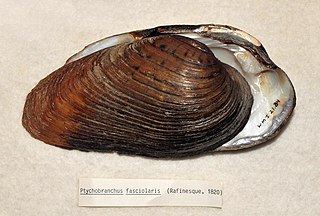
Ptychobranchus fasciolaris is a species of freshwater mussel in the family Unionidae, the river mussels. Its common name is kidneyshell.

Simpsonaias ambigua, the salamander mussel or mudpuppy mussel, is a species of bivalve in the family Unionidae. It is unique among freshwater mussels in using mudpuppies as its glochidial host. It is the only freshwater mussel known to have a non-fish host.
Cryptomastix devia, common name the Puget Oregonian snail, is a species of air-breathing land snail, a terrestrial pulmonate gastropod mollusc in the family Polygyridae.
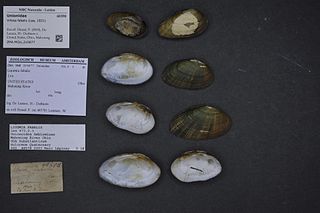
Villosa fabalis, the rayed bean, is a species of freshwater mussel, an aquatic bivalve mollusk in the family Unionidae, the river mussels.
Pleurobema sintoxia, the round pigtoe, is a species of freshwater mussel, an aquatic bivalve mollusk in the family Unionidae, the river mussels.
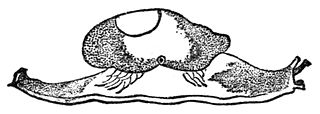
Hemphillia is a genus of air-breathing land slugs, terrestrial pulmonate gastropod mollusks in the family Arionidae, the roundback slugs.

The Hemphillia glandulosa, common name the warty jumping-slug, is a species of air-breathing land slug, a terrestrial pulmonate gastropod mollusk in the family Arionidae.
Gonidea angulata, the western ridged mussel or Rocky Mountain ridged mussel, is a species of freshwater mussel, an aquatic bivalve mollusk in the family Unionidae, the river mussels. It is the only species in the genus Gonidea.
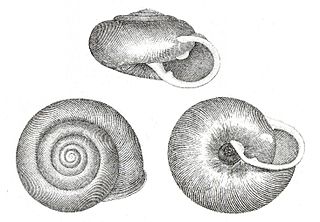
The Appalachina sayana, also known as the Spike-lip Crater, is a species of small, air-breathing, land snails, terrestrial pulmonate gastropod molluscs in the family Polygyridae.
Lyogyrus granum, common name the squat duskysnail, is a species of very small or minute freshwater snail with a gill and an operculum, an aquatic gastropod mollusk in the family Hydrobiidae.
Deroceras hesperium, common name the evening fieldslug, is a species of air-breathing land slug, a terrestrial pulmonate gastropod mollusk in the family Agriolimacidae.
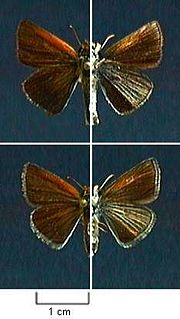
Oarisma poweshiek, the Poweshiek skipperling, is a North American butterfly in the family Hesperiidae (skippers), subfamily Hesperiinae. The range of this species in Canada is restricted to southeastern Manitoba, and in the United States it historically ranged from the Dakotas to the southern Lower Peninsula of Michigan.

Dolphin and Union Caribou, Dolphin and Union caribou herd, Dolphin-Union, locally known as Island Caribou, are a migratory population of barren-ground caribou, Rangifer tarandus groenlandicus, that occupy Victoria Island in the Canadian Arctic Archipelago and the nearby mainland. They are endemic to Canada. They migrate across the Dolphin and Union Strait from their summer grazing on Victoria Island to their winter grazing area on the Nunavut-Northwest Territories mainland in Canada. It is unusual for North American caribou to seasonally cross sea ice and the only other caribou to do so are the Peary caribou who are smaller in size and population. They were listed as Special Concern by Committee on the Status of Endangered Wildlife in Canada (COSEWIC) since May 2004.
References
- ↑ Branson B. A. (1972). "Hemphillia dromedarius, a new arionid slug from Washington". The Nautilus 85: 100–106.
- ↑ COSEWIC 2003. COSEWIC assessment and status report on the dromedary jumping-slug Hemphillia dromedarius in Canada. Committee on the Status of Endangered Wildlife in Canada. Ottawa. vi + 21 pp. http://www.sararegistry.gc.ca/virtual_sara/files/cosewic/sr_dromedary_jumping_slug_e.pdf
- ↑ COSEWIC. 2005. Canadian Species at Risk. Committee on the Status of Endangered Wildlife in Canada. 64 pp., page 20.